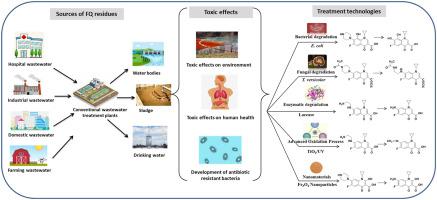Environmental Pollution ( IF 7.6 ) Pub Date : 2021-09-25 , DOI: 10.1016/j.envpol.2021.118233 Purvi Mathur 1 , Doyeli Sanyal 2 , Damien L Callahan 3 , Xavier A Conlan 4 , Frederick M Pfeffer 4

|
Antibiotic proliferation in the environment and their persistent nature is an issue of global concern as they induce antibiotic resistance threatening both human health and the ecosystem. Antibiotics have therefore been categorized as emerging pollutants. Fluoroquinolone (FQs) antibiotics are an emerging class of contaminants that are used extensively in human and veterinary medicine. The recalcitrant nature of fluoroquinolones has led to their presence in wastewater, effluents and water bodies. Even at a low concentration, FQs can stimulate antibacterial resistance. The main sources of FQ contamination include waste from pharmaceutical manufacturing industries, hospitals and households that ultimately reaches the wastewater treatment plants (WWTPs). The conventional WWTPs are unable to completely remove FQs due to their chemical stability. Therefore, the development and implementation of more efficient, economical, convenient treatment and removal technologies are needed to adequately address the issue. This review provides an overview of the technologies available for the removal of fluoroquinolone antibiotics from wastewater including adsorptive removal, advanced oxidation processes, removal using non-carbon based nanomaterials, microbial degradation and enzymatic degradation. Each treatment technology is discussed on its merits and limitations and a comparative view is presented on the choice of an advanced treatment process for future studies and implementation. A discussion on the commercialization potential and eco-friendliness of each technology is also included in the review. The importance of metabolite identification and their residual toxicity determination has been emphasized. The last section of the review provides an overview of the policy interventions and regulatory frameworks that aid in retrofitting antibiotics as a central key focus contaminant and thereby defining the discharge limits for antibiotics and establishing safe manufacturing practices.
中文翻译:

减轻顽固性氟喹诺酮类抗生素对环境和人类健康有害影响的治疗技术
抗生素在环境中的扩散及其持久性是一个全球关注的问题,因为它们会导致威胁人类健康和生态系统的抗生素耐药性。因此,抗生素被归类为新兴污染物。氟喹诺酮 (FQ) 抗生素是一类新兴的污染物,广泛用于人类和兽医学。氟喹诺酮类药物的顽固性质导致它们存在于废水、流出物和水体中。即使在低浓度下,FQs 也能刺激抗菌素耐药性。FQ 污染的主要来源包括来自制药行业、医院和家庭的废物,这些废物最终会到达污水处理厂 (WWTP)。由于其化学稳定性,传统污水处理厂无法完全去除 FQ。因此,需要开发和实施更高效、经济、方便的处理和去除技术来充分解决这个问题。本综述概述了可用于从废水中去除氟喹诺酮类抗生素的技术,包括吸附去除、高级氧化工艺、使用非碳纳米材料去除、微生物降解和酶促降解。讨论了每种处理技术的优点和局限性,并针对未来研究和实施的高级处理工艺的选择提出了比较观点。评论中还讨论了每种技术的商业化潜力和生态友好性。代谢物鉴定及其残留毒性测定的重要性已得到强调。审查的最后一部分概述了政策干预和监管框架,这些政策干预和监管框架有助于将抗生素改造为核心重点污染物,从而确定抗生素的排放限值并建立安全生产规范。











































 京公网安备 11010802027423号
京公网安备 11010802027423号